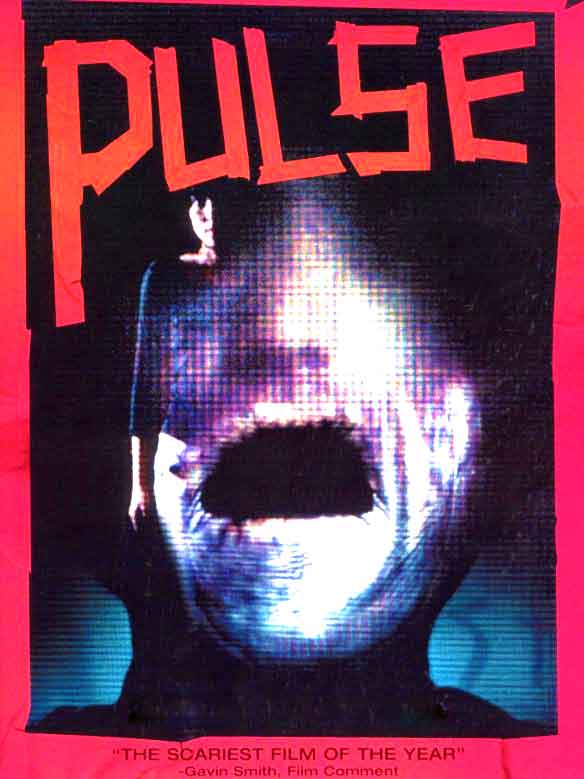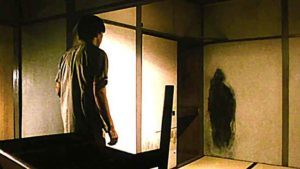 No, this isn’t the lame Hollywood PULSE from 2006, but the 2001 Japanese original, directed by the skilled Kiyoshi Kurosawa. All of Kurosawa’s predilections (as seen in CURE, CHARISMA and SÉANCE) are on display here, which include a rigorously controlled atmosphere and an agonizing refusal to fully explain the particulars of the narrative.
No, this isn’t the lame Hollywood PULSE from 2006, but the 2001 Japanese original, directed by the skilled Kiyoshi Kurosawa. All of Kurosawa’s predilections (as seen in CURE, CHARISMA and SÉANCE) are on display here, which include a rigorously controlled atmosphere and an agonizing refusal to fully explain the particulars of the narrative.
No, this isn’t the lame Hollywood PULSE from 2006, but the 2001 Japanese original, directed by the skilled Kiyoshi Kurosawa.
There have been several claims of PULSE (KAIRO) being the scariest movie ever, and the apparent “masterpiece” of Kiyoshi Kurosawa. Whoever said those things was wrong on both counts, even though PULSE was one of key films of the J-Horror boom of the early ’00s. It wasn’t officially released in the U.S. until 2005, yet had by that point gained considerable popularity on the greymarket DVD circuit. And yes, it was remade by Hollywood in 2006, but that version has already been largely forgotten, and with good reason.
…one of key films of the J-Horror boom of the early ’00s..
A group of young friends living in Tokyo are rocked by the inexplicable suicide of their peer Taguchi. Yet one of Taguchi’s buddies finds that his dial-up internet connection turns itself on one night, and later on he gets a phone call from an unknown someone. Taguchi’s ghost actually appears standing motionless in the home of one of his pals—and then disappears, leaving behind an ashy stain. An unidentified ghostly woman also turns up and then vanishes.
Another suicide occurs—a woman climbs to the top of a tall tank and leaps to her death–and yet another ghostly figure is spotted, this time in a library.
One of the protagonists suggests that the spirit world has become overcrowded, so its denizens are seeping into the mortal world via the internet! Once here those spirits are apparently inspiring people to commit suicide. In the meantime more and more ghosts are spotted throughout Tokyo, and suicides proliferate until the city is all-but deserted, with only the naïve protagonists alive…but are they truly “alive?”
 What gives Kiyoshi Kurosawa’s movies their distinction is his artful treatment. His films are spare, even-tempered and highly idiosyncratic, and don’t play like traditional horror movies, Japanese or otherwise. PULSE’S atmosphere is thoroughly and convincingly naturalistic, which makes the supernatural intrusions all the more affecting. The idea of the internet as the source of a ghostly infestation doesn’t seem all that unprecedented nowadays, but it was when the film was first released, meaning it has an original premise (even if it does owe something to the phenomenally popular RINGU).
What gives Kiyoshi Kurosawa’s movies their distinction is his artful treatment. His films are spare, even-tempered and highly idiosyncratic, and don’t play like traditional horror movies, Japanese or otherwise. PULSE’S atmosphere is thoroughly and convincingly naturalistic, which makes the supernatural intrusions all the more affecting. The idea of the internet as the source of a ghostly infestation doesn’t seem all that unprecedented nowadays, but it was when the film was first released, meaning it has an original premise (even if it does owe something to the phenomenally popular RINGU).
…spare, even-tempered and highly idiosyncratic…
Concentration is another Kurosawa’s virtues. This film is quite pointed and concise, so much so that Kurosawa doesn’t need to result to traditional movie scare methods (fast cutting, noisy music cues, etc) to make his points.
That’s not to say, however, that PULSE is particularly coherent. Kurosawa has always favored ambiguity (a prime reason his films are liked by art film patrons) and that’s quite true in PULSE, which appears to have an extremely involved narrative but lacks the connective tissue to play like anything more than a disconnected succession of impeccably executed scare sequences.
Vital Statistics
PULSE (KAIRO)
Kadokawa Pictures/NTV Network/Hakuhodo Inc./Imagica Corp.
Director: Kiyoshi Kurosawa
Producers: Shun Shimizu, Seiji Okuda, Takeshi Inoue, Atsuyuki Shimoda
Screenplay: Kiyoshi Kurosawa
Cinematography: Junichiro Hayashi
Editing: Jyunichi Kikuchi
Cast: Haruhiko Kato, Kumiko Aso, Koyuki, Kurume Arisaka, Masatoshi Matsuo, Show Aikawa, Jun Fubuki, Shinji Takeda, Koji Yakusho
